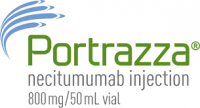
Necitumumab is an anti-EGFR recombinant human monoclonal antibody of the IgG1 kappa isotype that specifically binds to the ligand binding site of the human EGFR. Necitumumab has an approximate molecular weight of 144.8 kDa. Necitumumab is produced in genetically engineered mammalian NS0 cells.
|
PARAMETER |
DATA |
|
Manufacturer |
Eli Lilly and Company |
|
Indication |
PORTRAZZA™ is an epidermal growth factor receptor (EGFR) antagonist indicated, in combination with gemcitabine and cisplatin, for first-line treatment of patients with metastatic squamous non-small cell lung cancer. |
|
Cell Substrate |
NS0 (mouse) cell line. |
|
Manufacturing platform |
The upstream manufacture of each batch of necitumumab begins with the thawing of a single vial of the Working Cell Bank (WCB), derived from the Master Cell Bank (MCB), that is serially scaled-up in flasks and bioreactors. The contents of the final scale-up bioreactor are used to inoculate the production bioreactor. The culture is harvested, clarified, and then transferred for further downstream processing. The downstream manufacture of necitumumab consists of a series of chromatography, viral inactivation and nanofiltration and tangential flow filtration steps. Four manufacturing processes for necitumumab have been developed: Process A, Process B, Process C, and Process D. |
|
Dose in vial/final container |
800 mg/50 mL (16 mg/mL) solution in a single-dose vial. |
|
Dose to patient |
800 mg (absolute dose) as an intravenous infusion over 60 minutes on Days 1 and 8 of each 3-week cycle. |
CLINICAL TRIALS
|
NCT |
TRIAL PHASE |
NO OF PATIENTS ENROLLED |
TITLE |
COUNTRIES |
|
Randomized controlled study to support efficacy and safety |
||||
|
NCT00981058 |
3 |
1093 |
United States, Australia, Spain, Austria, Brazil, Belgium, Italy, France, Canada, Croatia, Greece, Germany, Korea, Republic of, Hungary, Philippines, Poland, Serbia, Portugal, South Africa, Taiwan, Romania, Singapore, Russian Federation, Slovakia, Thailand, United Kingdom |
|
|
Randomized controlled study to support safety |
||||
|
NCT00982111 |
3 |
633 |
United States, Australia, Austria, Belgium, Brazil, Canada, Croatia, France, Germany, Greece, Hungary, Italy, Poland, Portugal, Romania, Spain, Russian Federation, Slovakia, South Africa, United Kingdom |
|
|
Other studies to support safety and efficacy |
||||
|
NCT00801177 |
1 |
60 |
Study of IMC-11F8 in Patients with Tumors Who Have Not Responded to Standard Therapy |
Netherlands |
|
NCT01088464 |
1 |
15 |
Study of IMC-11F8 in Participants with Advanced Solid Tumors |
Japan |
|
NCT01606748 |
2 |
35 |
A Drug-Interaction Study of necitumumab (IMC-11F8) in Combination with Gemcitabine-Cisplatin |
United States |
|
Study in other indications |
||||
|
NCT00835185 |
2 |
44 |
Belgium, Spain |
|
|
Ongoing studies |
||||
|
NCT01624467 |
2 |
75 |
A Study of Necitumumab Monotherapy and the QT/QTc Interval in Patient with Advanced Solid Tumors |
United States |
|
NCT01788566 |
2 |
61 |
United States, Canada, France, Mexico, Spain, Netherlands, Taiwan |
|
|
NCT01769391 |
2 |
167 |
United States, Germany, Korea, Republic of, Poland, Mexico, Russian Federation |
|
|
US pre-IND |
December 5, 2008 |
|
US Approval |
November 24, 2015 |
|
EU Approval |
February 15, 2016 |
|
Health Canada Approval |
March 16, 2017 |
|
Japanese Ministry of Health, Labor and Welfare (MHLW) Approval |
November 22, 2019 |
This BLA was referred to the Oncologic Drugs Advisory Committee (ODAC) for advice and presented on July 9, 2015. The majority of the committee agreed that the efficacy and safety results of SQUIRE in squamous cell NSCLC support a positive benefit: risk assessment of necitumumab in combination with gemcitabine/cisplatin in the proposed population. Most of the committee members noted that the 16% reduced risk of death and median 1.6-month survival benefit with necitumumab in the pivotal SQUIRE study is modest yet significant and noteworthy. Some committee members advised that consideration should be given to recommending against use in patient subgroups that appeared to gain little or no benefit from the antiEGFR monoclonal antibody, such as patients over age 70 years and those whose tumors do not express EFGR proteins. Please see the transcript for details of the committee discussion.